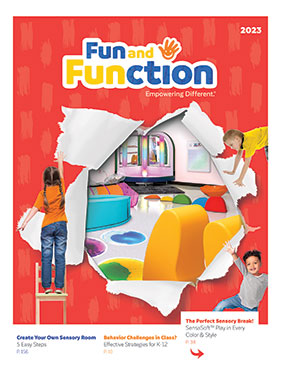For many kids, having to sit still and be quiet through an entire school day can seem like an impossible task. While most schools have physical education and recess built into the day, for some students, it’s simply not enough. Luckily, a lot of teachers and classrooms are becoming more aware of this need and are making changes to help those kids. Some teachers allow kids to keep fidgets at their desk or during circle time, while others have replaced regular chairs with alternative classroom seating.
Sensory hallways are a great way to add some extra sensory input for fidgeting kids throughout the day. Sensory hallways allow the transitions between lunch, recess, and classrooms to be interactive and fun! Create some walls with different textures using our Sensory Mini Mats. They let kids run their hands along them to release a bit of energy, while still keeping class lines moving. For more active hallways we offer a selection of wall panels for spinning, mazing, puzzling and playing for any budget. You can even get creative with the floor of your hallways and stick adhesive obstacle courses, activity maps and more. This can be tailored to your school or class’ exact needs, and what teacher doesn’t love a little DIY project?
Designed to give students a “brain break,” the path activities provide sensory input to help stay on task. Sensory hallways are designed as a preventative measure, improving focus and preventing disruptive behaviors from occurring within the classroom environment. After following the sensory path, students can return to the classroom focused and ready to learn.
Try these activities to create your own sensory path and create a brain break in the sensory hallway!
- Jumping and counting just go together. You can skip rope and count, or just jump and count.
- Position a few Spot Markers or Squeaky Spots and jump from spot to spot as you count or follow a color pattern.
- Incorporate hopscotch or bear crawling using the Jumper Mat or Gel Floor Tiles to work on balancing and bilateral coordination activities.
- Walk across a Balance Beam encouraging students to not let their feet hit the floor. Position Balance Blocks on the floor to encourage hopping on one foot.
- Create an obstacle course that has to be navigated with a Scooter to encourage gross motor skills and deep pressure input.
- Position the Emotions Cushions on the floor like stepping stones. Put them in a circle or in a snake like figure to work on balance, jumping, color recognition and emotion recognition.
- Line up our Sensasoft Texture Track to create a walking path, hopscotch pattern, or a mixture of motor patterns to promote motor planning and stretching.
- Place Sensory Mini Mats on the wall for wall push up patterns, or on the floor for a textured experience as sensory steps.
- Keep hands busy while walking down the hall with one of our Interaction Boards Interaction Boards.
- Mount a Sensory Wall Panel with activities that integrate acoustics as well as visual and tactile elements.
Introducing sensory paths or hallways can help positively transform the school experience for kids. Providing the opportunities for movement and incorporating sensory input can help a child become calm and more focused, which will impact participation. For students who can’t sit still, sensory paths are an appropriate way to discharge energy without disrupting others. How fun would it be for all students to use sensory paths to support learning?
Explore our custom sensory hallway options.
This post was originally posted on 10/11/2019 by. It was updated for accuracy and comprehensiveness on 02/02/2022.




















Comments